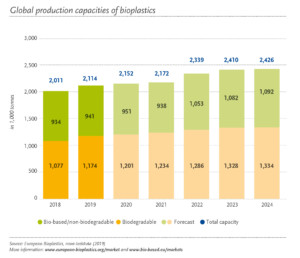
Global Production Capacities 2018-2024
According to the recently published new market data 2019, the global bioplastics industry will continue to grow dynamically. “In an increasingly environmentally conscious context, the global market for bioplastics is predicted to grow by more than 15 percent over the next five years“, says Hasso von Pogrell, Managing Director of European Bioplastics. “This trend is possible thanks to the steadily increasing demand for sustainable products by both consumers and brands alike and the continuous efforts of the bioplastics industry to develop innovative materials with improved properties and new functionalities.”
The global bioplastics production capacity is set to increase from around 2.1 million tonnes in 2019 to 2.4 million tonnes in 2024. Innovative biopolymers such as PP (polypropylene) and PHAs (polyhydroxyalkanoates) are driving this growth. Bio-based, non-biodegradable plastics, including the drop-in solutions bio-based PE (polyethylene) and bio-based PET (polyethylene terephthalate), as well as bio-based PA (polyamides), currently make up for around 44 percent (almost 1 million tonnes) of the global bioplastics production capacities. Intentions to increase production capacities for bio-based PET, however, have not been realised nearly at the rate predicted in previous years, but actually declined over the years. Instead, the focus has shifted to the development of PEF (polyethylene furanoate), a new polymer that is expected to enter the market in 2023.
Packaging remains the largest field of application for bioplastics with almost 53 percent (1.14 million tonnes) of the total bioplastics market in 2019. The data also confirms that bioplastics materials are already being used in many other sectors, and the portfolio of application continues to diversify. Segments, such as automotive & transport or building & construction, significantly increased their relative share.
The land used to grow the renewable feedstock for the production of bioplastics is estimated to be 0.7 million hectares in 2019, and continues to account for only around 0.02 percent of the global agricultural area of 4.8 billion hectares. Despite the market growth predicted in the next five years, the land use share for bioplastics will remain at only around 0.02 percent. “The data shows once more that there is no competition between renewable feedstock for food and feed, and the use for bioplastics” says Francois de Bie, Chairman of European Bioplastics, “94 percent of all arable land is used for pasture, feed and food.”